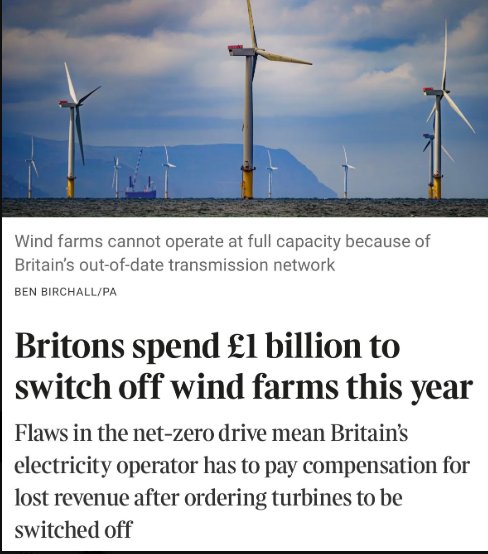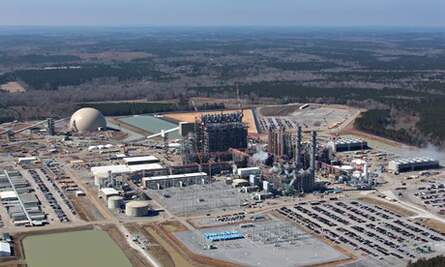Just a thought on your earlier post Lincs…
Isn’t the fashion industry one of the worlds major polluters?
Just a thought on your earlier post Lincs…
Isn’t the fashion industry one of the worlds major polluters?
Yes but primarily the fast fashion low cost end of the industry, such as your favourite shop Primark. Less so the high end.
But none on the same scale as the coal industry while it was in full polluting output.
The reckless use of burning coal in every dwelling, especially in over populated areas was a mistake. However, burning coal and it’s associated gas to supply cheap electricity would have a more favourable outcome providing houses with clean heating, far cheaper than the totally ridiculous assumption that green ‘sustainable’ energy from wind and solar would ever work out cheaper than coal or gas fired power stations. The proof of the pudding etc…
No energy is ‘sustainable’ and the amount of pollution created by the manufacturing and siting of hundreds of acres of glass panels, or filling the horizon with hundreds of wind turbines. Farmland is precious in an ever expanding population, and a Combined Cycle Gas Turbine power station takes up a fraction of the land required by ‘Sustainable’ green energy alternatives. And will keep the lights on 24/7.
Modern technology would be better employed figuring out how to make burning coal and oil less polluting, than spending billions of pounds/dollars on bad science…

The Slag heaps are being landscaped, bit like applying a sticking plaster on a Sarcoma
MIT’s 'supercomputer says civilization as we all know it will end by 2040!
I will most likely end by then too!
I offer my grandkids ways to learn and deal with them!
Does it give a specific date? it’s possible to guess.
MIT - Massachusetts Institute of Technology**+3**
Its a sad fact, give Humans a planet and they’ll “Asset Strip” it
I saw today that 'amazing intends to lay off 14,000 upper employees from offices.
Not sure its that simple.
Guilty by association and all that
Burning coal = clean heating. I am not entirely sure how the two things sit together. I know you meant “clean heating at point of use” but that completely ignores “dirty energy at point of production”.
Here’s the thing - the cost of renewable energy is primarily the set up cost. If today we decide to build a big coal fired power station then we could make a decent comparison of the two production costs … and coal would no longer look cheaper. And the millions of tons of bricks and concrete needed to build such a coal power station would be as damaging as the production of a solar farm. You need to compare like with like.
And as for the article you shared about paying for switched off wind turbines - I’ve rarely seen a better reason to nationalise the UK’s energy sector. This daft set up of compensating private power consumption in times of over supply (hey, it can also happen with gas and coal power stations) is only happening because of the ridiculously complex and costly private model that the UK has. The multi-layered UK model is also why the UK electricity costs so much. It is a failed model that everyone is paying for.
By producing free or cheap electricity would mean that people would prefer to heat their homes using electricity, rather than gas or wood and solid fuel burners.
Did I mention that with today’s technology it should be possible to prevent much of the pollution that burning coal produces, and all the pollution would be in one place away from heavily populated areas. I also mentioned Combined Cycle Gas Fired power stations, one is being constructed near to me to make up for the inefficiencies of part time power and the need for huge and dangerous, battery storage systems.
An onshore wind turbine can output 2 to 3 mega watts of energy, an average coal or gas turbine power station produces around four or five gigawatts of energy…
That’s the equivalent of almost one thousand onshore wind turbines, and the power output of the power station can regulated to deliver power when it’s needed.
Modern power stations are not constructed from bricks, and as for the millions of tons of concrete needed to build a power station, how much cement do you think it takes to build one wind turbine? And each unit is a stand alone turbine. Apparently there is some concern about the deep foundations needed for a wind turbine, the block of cement will be there for the life of the planet.
Consider that nearly all wind turbines are now made in China and shipped to the UK, that’s quite a lot of pollution before you start producing energy. And I’ve not even started on solar panels or battery storage units yet… ![]()
You could probably site half a dozen gas fired power stations, all turning out 4 gW of energy on the land covered by one large solar farm, and it takes an awful lot of heat to produce all those glass panels.
Wind turbine blades don’t last very long, especially one sited out to sea. There is currently no method of recycling them so they go to landfill…
As for the solar panels…
Very costly and and not widespread, in fact, the bloke keeps saying “By 2030” or “By 2040” so on a mass scale it’s currently pie in the sky…
This is not completely thought out is it? First, there is no electricity production method which results in free or cheap electricity - least of all from building a new coal power station. So that is not an argument in any way. Second, getting individual houses away from their own fossil fuel heat source is also an argument for wind / solar generated electricity. So my note about clean house but dirty production stands but only for coal generation, not for wind /solar. For wind / solar the statement becomes clean house and clean production.
Note - here I mean production of electricity, not production of the kit that produces the electricity. So let’s consider the production of the kit that produces electricity.
All electricity production is expensive to create - with nuclear being the most expensive. Coal power stations with any sort of carbon capture (not a new tech and only a partially effective tech for reducing emissions) are expensive. A small plant, in the 100-200 MW range (way off the 3 GW you talked about) would be in the order of £2bn - possibly more if land purchase and financing were taken into account. This number is based on existing and scrapped fossil fuel power stations with carbon capture. One plant of 500 MW in the US ended up at $7bn. And then you need to add in the cost of the fuel itself. And the waste product processing. And the site management - many more people day to day than a wind farm or solar farm.
Note - at 500 MW a win farm need only have 170 turbines. That is not going to cost $7bn, (£5bn) it would be more like £500million. There is no comparison.
However your point was not about the cost of setting up a modern coal fired power station. You wanted to focus on the materials & components and also on the gaps in electricity production. As for gaps - solved long time ago with hydro-plants and now also with investment in the right electricity distribution infrastructure. As for materials:

Are you thinking that this “clean” power station is using less materials than a hundred wind turbines? And that the long term environmental impact is less?
Looks like your side of the woods as poorly run as ours but truth is every country is.
Kim Kardashian who is most beloved here in the states would disagree with you .
I see more and more solar going up here on roofs but I have not seen outside any of the home owners , I do know them enough to discuss this but I have not been able to catch any outside as would love to find out the cost , pros , etc .
One is an older " Gentlemen " like myself and he has them on one side of roof so would think cost effective but again have not chatted with any of them .
Our home is near 3/4 solar and wind electricity powered. It costs a bit more $50 a month for it.
I do believe in Technology advances and the cost is sort of adjustable by turning things off in the house.
The house 71 F at night, the hot water heater set on warm not scalding, weekly showers, not hot
Tub times now. … ![]() … If I get an achy, I will use the hot Sauna tubs benefits ! Many
… If I get an achy, I will use the hot Sauna tubs benefits ! Many
years ago I belonged to the YMCA and would do that there. My own Sauna is a good thing too.
The facts are 1000’s of acres are needed, new roads built to the turbines, special
intersections built so the long tractor trailers can turn and Millions of tons of gravel
Lime and cement poured. The gain is wind power. The loss is 1000’s of semi
trailer loads of rock, cement and all the mining of those basics. Basically, all the
Gravel quarries within 75 miles are stretched to their limits. Then With cracked turbine
blade replacements and maintenance constantly needed. Sure a few have blown /
burnt up, self-destructed too. To me Turbines seem a PITA !
They seem so much easier to install and maintain but the ones sitting on roofs of family homes seem dumb. … ![]() …
…
It’s not as simple as either or between the two. Solar panels are half as efficient in northern Europe (north US same) as ones sited in the south. Solar farms on sloping land are also less efficient. Whereas northern hilly places are often windy places. These generate electricity in the dark as well, remember.
But energy companies and governments do many calculations on investment costs, maintenance costs and projected price per MW. And many wind and solar sites are being built but few coal powered stations. What does that tell us?